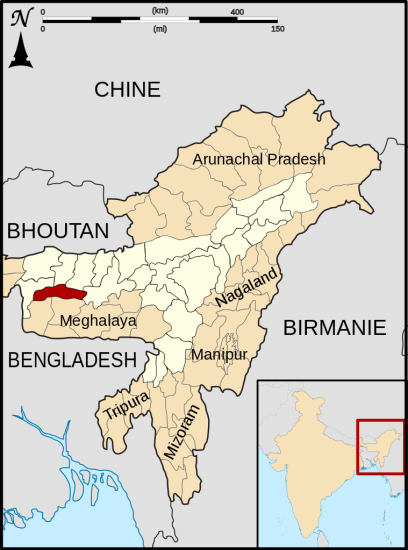Source - http://www.assamtribune.com/scripts/detailsnew.asp?id=apr1915/at054

Goalpara district's location in Assam
A team of the State’s Archaeology Directorate has found a rich archaeological site at Dekdhuwa village, about 10 km northwest of Goalpara town, on the southern bank of the Brahmaputra, which may be dated back to the 1st century BC to 2nd century AD.
The most important finding at the site is a single-line rock-cut inscription, which consists of six letters and is found on the cliff facing the Brahmaputra. This is believed to be one of the authentic epigraphic records of the area. Though the inscription is yet to be deciphered, it is assumed to be written in the Brahmi script.
The team comprising Director of Archaeology Deepi Rekha Kauli, technical officer Nabajit Deori, exploration officer Chabina Hassan and photographer Apurba Gogoi, found that the site has a brick-built settlement area and rock-cut art and architecture. Prof Paromita Das of the Gauhati University’s History Department accompanied the team.
The rock-cut structures are found scattered on a small hillock and the cliff facing the Brahmaputra. The settlement area is located adjacent to the riverbank on a highland area, said Nabajit Deori.
The remains of the brick structures are scattered over nearly 30 bighas of land. A brick enclosure wall, plinths of houses, temples and other architectural remains are found at the site. A rock-cut temple plinth, measuring 10x8 metres is seen at the brick settlement area.
The rock-cut art and architectures are found to be confined to the hillock and the cliff facing the river. In the hillock, 27 rock-cut Shiva Lingas with Yoni Pithas, curved on the rocky outcrop, have been found. These very unique and rare art works have similarities with the Suryapahar monuments.
Dekdhuwa Linga-Pithas are of various shapes and sizes. They are of two types – one is rounded Pitha with rock-cut Linga and the other is square Pitha with installed Linga. The largest Linga-Pitha is 103 cm, while the smallest one is only 20 cm in diameter. Traces of rock-cut post holes around some of the Linga-Pithas indicate existence of canopies over them. There is a possibility of more archaeological findings at the site if the existing vegetative cover is removed.
Similar rock-cut Linga-Pithas have been found on the cliff facing the Brahmaputra, nearly 300 metres south of the ones lying on the main hillock. At the site, five flights of rock-cut steps have been noticed emerging from the water level leading to the upper bank of the river. The flights consist of 61 steps, and lead to the rocky platform where seven rock-cut Linga-Pithas are found. An image of Shiva-Parvati with Ganesha appears in between the Linga-Pithas. In the middle of the cliff facing the river, a cluster of seven rock-cut Linga-Pithas, both rounded and square in shape, are found.
Besides, the team found two rock-cut caves on the cliff, which are similar to those at Jogighopa. The larger cave is 1.80 metres in height, 1.77 metres in width and 1.6 metres in depth. The smaller one is 1.54 metres high, 70 cm wide and 2.10 metres deep. Traces of installation of deities can clearly be seen inside the caves, though the images are missing.
The team also explored the terracotta and brick ruins of Rahmat Tila of Gobindapur area located on Goalpara-Pancharatna Road, at a distance of three kilometres west of Goalpara town.
Brick sizes of Rahmatpur and Dekhdhuwa are very large (37x22x7cm) and similar to the bricks at Sunga-Kushana period, Deori said.
The Archaeology Directorate will make necessary correspondence with the Goalpara district administration for notifying the physical possession and protection of the above sites, informed Deori.